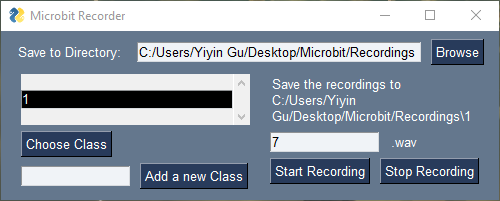- Python package requirements (updated March 4, 2022):
- Installation:
pip install -r requirements.txt - Write file:
pip freeze > requirements.txt- This should be done in a venv to avoid adding unnecessary packages
- May need to use pip3 in place of pip for commands to work, or alternatively use conda
- Installation:
- Basic Hardware Information:
- Micro::bit V2 Specs: Arm Cortex-M4, RAM 128KB, Flash 512KB
- Build-in microphone sensor (More details in notes)
- Code with python (micro-python):
- More details under Micropython folder
- the micropython encapsulation is too upper-level and it stops us from accessing some important features (like recording a voiceline), so it is not recommended
- Code with C++ (CODAL):
- Setup: See this microbit-v2-samples repository.
- The V2 version still doesn't have any online document, so I build the inline version with Doxygen and attach it under Docs/CODAL-V2.
- Clone the Repository and open the index.html under the directory mentioned above (or use the local link).
-
Data Preparation
- Existing Dataset:
- Spoken Digit Dataset
- number 0 to 9
- 6 speakers
- 3,000 recordings (50 of each digit per speaker)
- English pronunciations
- Spoken Digit Dataset
- Prepare it Ourselves
- Code a Voiceline Recorder with C++ on Microbit:
- Some References:
- Interface w/ python:
- Code a Voiceline Recorder with C++ on Microbit:
- Existing Dataset:
-
Voice Classification:
- Some References:
-
- Micro Speech Example
- Doesn't support Micro:bit out of the box
-
- the basic is similar to the Edge Impulse one, but they encapsulate their code into a micro-python library
- Probably because they want to use this as a teaching method, but this is not necessary for us
- See the original repo for documents and setup guide
- Build and flash the micropython environment on the board with this instruction
-
- Some References:
